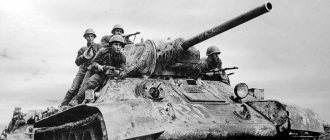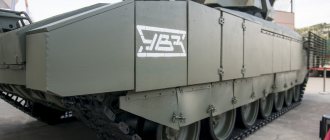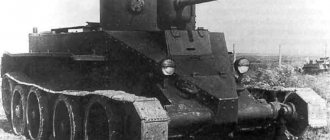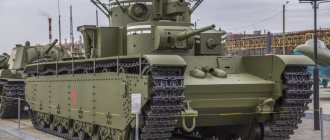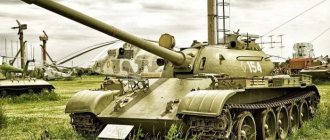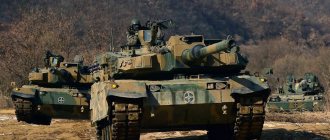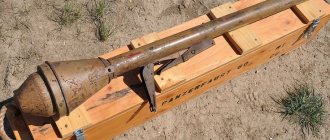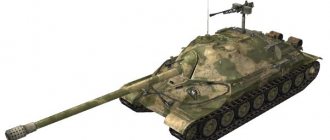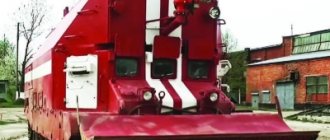In the history of world tank building, various bases have been used to classify combat vehicles. They were divided into groups and types, differing in armament and armor strength, speed and driving characteristics, features born under the influence of state military doctrine and tactics of units and formations.
The most popular classification is based on the combat weight of the tank: light, medium, heavy. The KV-1 tank was the first in a series of mass-produced Soviet heavy tanks.
Historical reference
It is known that the very first tank MK-I (Mark I) appeared on September 15, 1916 in the British Army. France did not lag behind its Entente ally, presenting its combat vehicle a little later. The Renault FT tank turned out to be quite a successful option and a model for many subsequent models.
Following the pioneers, Italy, Hungary, Poland, Sweden, Czechoslovakia, and Japan joined the tank building process.
It is curious, but the countries that are today producers of the best armored vehicles - Russia (USSR), the USA and Germany - entered this process with a certain delay.
The Soviet military command had virtually no experience in the construction and use of tanks.
It was difficult to call the use of combat vehicles captured from the interventionists and one and a half dozen tanks manufactured in 1920, on the basis of a slightly converted Renault (the first was called “Freedom Fighter Comrade Lenin”), an experience.
Therefore, having gone through the stage of finding their way faster than other tank-building countries, the creators of Soviet tanks found a more successful option.
Using the experience of others
During the Soviet period, they tried not to mention this, because the country of the Soviets was the first in everything. This “leavened patriotism” is to the detriment of historical truth. Yes, we didn’t invent the tank... Yes, our designers used the experience of others. And what's wrong with that?
In December 1929, a special commission created by the Department of Mechanization and Motorization of the Red Army was sent on a business trip abroad to study the production of tanks.
Were purchased:
- A sample of the light English tank "Vickers - 6 tons" with a production license.
- 15 MkII tanks, English-made.
- Several Carden-Lloyd MkVI wedges and a license for the production of this model.
- Two TZ tanks without turrets and weapons in the USA from engineer and inventor J.W. Christie is the author of the original chassis for the armored vehicle.
All these acquisitions were used in one way or another in the development of domestic tank models. On the basis of the English wedge, the T-27 wedge was created and put into mass production, which was in service with the Red Army even in the first months of the war.
When creating the T-26 tank, which in the pre-war years was the main one for the Red Army, the achievements, important components and assemblies of the Vickers - 6 tons combat vehicle were largely used. And the original chassis, invented by Christie, was first used on tanks of the BT family, and then on thirty-fours.
Dangerous rush
The hasty adoption of the KV into service by the Red Army played a dual role. On the one hand, by the beginning of the Great Patriotic War, the Red Army had at its disposal quite a few new vehicles that were superior in combat capabilities to any enemy tanks. This was brilliantly proven by several famous episodes of the complete defeat of numerous columns of the Nazis with just one (!) KV tank. Of course, the opponents were mainly light Czech Pz.35(t), but the medium “troikas” and “fours” of the first modifications were not a serious rival to the KVs, which could shoot them from a much greater distance.
On the other hand, the armored vehicle, suffering from numerous “childhood diseases,” brought a lot of headaches to the Soviet tank crews themselves. It is no coincidence that the most effective battles of the Great Patriotic War, mentioned above, were fought by KVs from tank ambushes. The low reliability of the transmission of these tanks became the talk of the town, and combat mobility was also low. The vehicle turned out to be strong and strong, but overweight; it often could not even fly up a slope that other tanks could easily climb.
If the KV, before it was put into service and began to be produced en masse, had gone through the traditional path for other tanks, with lengthy field tests, with repeated refinements and improvements to the deficiencies identified on them, perhaps its future fate would have been different. But the country was in a hurry to prepare for the approaching war, and it needed a strong vehicle that could withstand the fire of almost any enemy guns immediately. However, the T-34 was adopted in a similar way, which until the end of its career did not get rid of, for example, difficulties with changing gears, which is why the driver mechanics preferred to go into battle exclusively in second gear.
Serial production of the KV, which by that time, in connection with the appearance of the KV-2, armed with a 152-mm howitzer, had received the index KV-1, began already in February 1940 at the Kirov plant. The production rate was planned to be colossal, but it was not possible to maintain it. Therefore, Soviet tank crews met the Great Patriotic War with less than three hundred vehicles of this type in service. As the first battles showed, even with such a small saturation of troops with KV tanks, they are capable of causing a lot of trouble for the Germans. The problem was different: these tanks were not intended for counter or ambush tank battles or for use as infantry escort vehicles. Their element was breaking through fortified defense lines, and in the summer of 1941, if anyone broke through such lines, it was only the Germans. As a result, the KV had to perform tasks unusual for them and cover hundreds of kilometers to get to the place where they were to go into battle. Because of this, the mechanisms, especially the transmission, quickly wore out, and many “kaveshki,” as they began to be called in the army, were lost not in battle, but on the march.
To be a heavy tank
The second half of the 30s was a period when the world and, especially Europe, lived in anticipation of war. Countries responded differently to the difficult political environment. The role of armored forces in the future confrontation was ambiguously assessed.
The French and Italians viewed them as a means of supporting infantry and cavalry, giving them a supporting role. The British established the need to have two types of tanks: cruising and infantry, which performed different functions.
The Germans considered the use of tanks as part of large formations, which, with the support of aviation, should break through the defenses and move forward without waiting for the infantry.
The concept of Soviet military specialists provided for the use of all types of tanks to break through tactical defenses, to support infantry and develop success in the operational space, operating as part of tank and mechanized formations. But if the issues of improving light and medium vehicles in the pre-war period were resolved well, then the situation with heavy ones was worse.
The next attempts to create a heavy tank boiled down to strengthening the armor protection (as a consequence - increasing the mass of the tank) and using the common multi-turreted version (increasing dimensions), to the detriment of speed and maneuverability. Such vehicles and armor protection were lost. Fortunately, after the production of 59 units of the T-35 tank and its recognition as unpromising, work on creating heavy tanks went in a different direction.
In the history of the creation of a heavy tank, 1939 turned out to be the most successful:
- in February, the Leningrad Kirov Plant (LKZ) began development of the KV tank, named after the People's Commissar of Defense of the USSR, Kliment Efremovich Voroshilov;
- by the end of the year, the 185th plant completed the development of the 58-ton double-turret T-100 tank;
- another version of the heavy tank was the 55-ton model, also developed at LKZ and named after Sergei Mironovich Kirov - SMK;
- shortly after the outbreak of the Soviet-Finnish war in November 1939, all three samples were sent for testing to the combat area. The victory in this “competition” was won by the KV heavy tank, with one significant caveat. The military who conducted the test were not satisfied with the weak 76 mm gun for such a powerful tank;
- The decision was made to serially produce the KV tank.
One tower instead of three
The tank, which did not yet carry the KV index, owed its birth to two other Soviet heavy tanks that remained in experimental status - SMK (that is, Sergei Mironovich Kirov) and T-100. Both heavyweights were designed according to the classic multi-turret design of that time. This was required by the theory of the use of heavy tanks: designed to break through enemy fortifications, they had to have a weapon to combat bunkers, a weapon to combat enemy tanks and machine guns to combat enemy personnel. Therefore, both SMK and T-100 initially received three turrets, which later turned into two. As the legend goes, while Stalin was examining the models, he removed one of the towers and asked the chief designer of the Kirov Plant, Joseph Kotin, how much it weighed. Having learned that it was three tons, the Soviet leader demanded to get rid of the extra turret and increase its armor at its expense.
It is difficult to establish today whether such a dialogue actually took place. However, after one of the three towers was removed from the QMS, the design team of the Kirov Plant tried to remove another one - as an experiment. Under this condition, the long hull was no longer needed, and it was shortened into two road wheels, which immediately made the experimental tank more mobile. In addition to this, it was decided to install a different type of engine on the new car - the diesel V-2, the production of which was just being mastered in Kharkov.
The first experimental model of the new heavy tank, codenamed U-0, received a very unusual set of weapons from the current point of view. Both guns, which befit a breakthrough tank, were squeezed into a single turret: a 76-mm main gun and a 45-mm anti-tank gun. At the same time, the ammunition load of the “main” gun was more than a hundred shells, and the “auxiliary” one – only fifty. During field tests, it quickly became clear that such a duplex did not give the tank any advantage in battle, but made life difficult for the crew, who were forced to cram into a small turret.
From KV to IS-2
The practice of replacing official names, alphanumeric designations, with other, humorous names has always existed in the army environment. Certain types of weapons received an official name in the form of the initial letters of the full name of their creator.
But the tank, with the exception of the “Freedom Fighter...,” was named after the People’s Commissar of Defense for the first time. No sarcasm, but the cliche involuntarily suggests itself about how you name a ship, so it will sail. Hero of the Civil War, Marshal of the Soviet Union, People's Commissar of Defense K.E. Voroshilov, who was not replaced for 15 years, did not make a special contribution to Victory in the war. Moreover, by the end of the war, he, the only one in all the years, was removed from the State Defense Committee.
So the KV-1 tank seemed to exist, but it was not born with that name and did not complete its life’s journey with it.
- in 1939, the KV heavy tank was developed and sent for testing at LKZ;
- in the summer of 1940, the KV tank with a 76 mm L-11 cannon was put into mass production (in 1941 it was replaced by a more advanced, but of the same caliber, ZIS-5 cannon) and the KV-2 tank with a 152 mm M10T howitzer was created;
- but serial number 1 was assigned to the tank “retroactively”, not in connection with the appearance of a new modification, but so as not to break the sequence;
- after the production of the KV (KV-1) and KV-2 ceased in 1941, the combat vehicle, having undergone some technical changes, and having received an 85 mm cannon, became known as the KV-85 in the summer of 1943;
- in the fall of 1943, based on the latest modification of the KV family, the IS-1 or IS-85 heavy tank began to be mass-produced. And after installing a 122 mm gun and changing the hull, on October 31, 1943, production of the IS-2 tank (Joseph Stalin) began, which in the early stages was known under the designation KV-122.
It is symbolic that, having freed K.E. Voroshilov from all key posts, Stalin replaced his name with his own in the name of the main tank. Replacing it with the name of any other military leader would be an insult to the former People's Commissar.
After such a lyrical digression, it is worth getting acquainted in detail with the first Soviet heavy tank KV-1 (there is no point in remembering the T-35) and comparing it with subsequent models. After all, by and large, these models are interconnected.
History of creation
The need to create a combat vehicle capable of withstanding heavy enemy artillery and equipped with powerful weapons had been brewing for a long time by 1938, when the corresponding resolution of the Soviet Defense Committee was adopted. In addition to the design bureau of the Kirov plant in Leningrad, another enterprise in the city, No. 185, received a similar technical assignment.
The problem of overcoming fortified lines arose during the First World War. Military theorists have put forward many ideas, one of which is the creation of armored vehicles that protect the attacking side from enemy attacks and are capable of destroying the most powerful fortifications.
In the 30s of the twentieth century, the idea of creating combat vehicles equipped with several towers was popular. This direction was considered a priority, and the future HF, which at the design stage received the name SMK after S.M. Kirov, it was supposed to be built with three towers.
Leningrad Kirov Plant
However, the model created by young engineers with a single turret, a powerful gun and a diesel engine proved its advantages over more fashionable analogues and went into mass production.
On a note! Decoding the name of the KV - Klim Voroshilov. Initially, there was no digital index in the marking, appearing after the start of production of the next model, number 2.
The first samples of KV-1 tanks received their baptism of fire while storming the Mannerheim Line in the Finnish War, where they were sent instead of field tests. The order for adoption was signed on December 19, 1939, just two days after the first battle involving this combat vehicle. The developed analogues - SMK and T-100 - also performed well in the Finnish campaign, but could not withstand the competition with the KV-1 tanks, being inferior in armor thickness with greater weight and worse dynamic characteristics.
Main characteristics of Soviet heavy tanks during the Great Patriotic War
| Main characteristics | Tank KV 1 | Tank KV 2 | Tank IS 2 |
| Combat weight (t) | 43 | 52 | 46 |
| Crew (persons) | 5 | 6 | 4 |
| Dimensions (mm) | |||
| length | 6675 | 6950 | 6770 |
| width | 3320 | 3320 | 3070 |
| height | 2710 | 3250 | 2630 |
| Clearance (mm) | 450 | 430 | 420 |
| Armor thickness (mm) | 40-75 | 40-75 | 60-120 |
| Gun caliber (mm) | 76 | 152 | 122 |
| Machine guns | 3x7.62 | 3x7.62 | 3x7.62, 1x 12.7 (DShK) |
| Ammunition (artillery rounds) | 90 | 36 | 28 |
| Engine power (hp) | 500 | 600 | 580 |
| Maksim. Speed | 34 | 34 | 37 |
| Highway range (km) | 225 | 250 | 240 |
| Off-road (km) | 180 | 150 | 160 |
| Overcoming obstacles (m) | |||
| wall | 0,87 | 0,87 | 1 |
| ditch | 2,7 | 2,7 | 3,5 |
| ford | 1,3 | 1,6 | 1,3 |
The tactical and technical characteristics, both presented in the table and those remaining outside of it, evaluate the three main components of any armored vehicle:
- armor protection and survivability of the tank and crew;
- firepower of weapons;
- speed and maneuverability.
How to play?
First of all, I advise you to use auto-aim. In the turmoil of battle, when you are circled by the enemy's lt or st, there is often simply no time. And given the excellent armor penetration of tanks of your level, it doesn’t matter where you land - for you, any “firefly” is like cardboard.
The KV-1 is a very comfortable tank and is relatively easy to play. You have good all-round armor. Tanking with a diamond (side) and only with a diamond will help you realize it 100%, and good gun depression angles allow you to tank with a strong turret.
Tank design and protection
Some experts consider the KV-1 tank to be a milestone in world tank building, because some technical discoveries were subsequently used in many other models. These are a diesel engine, projectile-proof armor, individual torsion bar suspension, division of the armored hull into sections: combat, control and engine-transmission.
The tank crew is more protected in such conditions. The driver and gunner-radio operator are located in the control compartment, the remaining crew members are in the combat compartment, both of them are separated from the engine compartment.
The armor protection of the hull and turret - welded armor plates with a thickness of 80, 40, 30, 20 mm - withstood hits of 37 and 50 mm from standard Wehrmacht anti-tank guns. It was not always sufficient for protection against larger calibers - the German 88 mm Flak 18/36 anti-aircraft gun became one of the main means of combating this Soviet tank.
Production
Serial production of KV-1 tanks began in February 1940. The machine was produced by the Kirov Plant in Leningrad, and by the end of the year production was mastered by the Chelyabinsk Tractor Plant.
Difficulties with setting up a new industrial line did not allow the planned production program to be completed at ChTZ, where only a few machines were produced. By the end of 1940, 139 KV-1 units were produced, and before the start of the Second World War, another 293.
The plans for 1941 included the release of:
- Kirov Plant - thousands of units;
- ChTZ - two hundred cars.
The scale of production was spurred by the attack on the USSR by Nazi Germany. Other enterprises joined the production of individual components. With the development of the German offensive, production was evacuated to Chelyabinsk, where from October 1941 ChTZ became known as the Chelyabinsk Kirov Plant of the People's Commissariat of Tank Industry. At this enterprise, popularly called Tankograd, most Soviet heavy tanks and self-propelled guns were produced, including various models and modifications of the KV.
Having overcome the difficulties of evacuation and establishing a technological cycle at a new location, Tankograd supplied the front with the following number of KV tanks:
- in the second half of 1941 - 933 vehicles;
- in 1942 - 2553 units, including the rest of the series.
Production did not stop in besieged Leningrad. Plant No. 371 in 1941 assembled more than sixty units of combat vehicles from the remaining components.
In total, over three and a half thousand units of KV series models were produced over the years of production.
KV-1 armament
The first KV models were equipped with a 76 mm F-32 cannon. It was against her that there were complaints when testing the tank on the Karelian Isthmus. The replacement with a 152 mm howitzer led to the appearance of the KV-2 tank model. But the KV-1 also underwent changes in armament by 1941, receiving a more advanced ZIS-5 cannon. The ammunition load was 90 artillery rounds of unitary loading. The shells were located on the sides of the fighting compartment.
The tank had an electric motor for turning the turret.
The tank's armament included three 7.62 mm DT-29 machine guns: coaxial with a cannon, forward and rear. All of them were removable and could be used outside the tank if necessary. A certain difficulty in conducting combat was caused by poor visibility for both the driver and the tank commander. Two sights were used for firing: TOD-6 for direct fire and PT-6 for firing from closed firing positions.
Design
By 1940 standards, the design of the KV-1 production model embodied the advanced ideas of tank building of the era. The classic layout of the vehicle was developed using a custom torsion bar suspension, reliable anti-artillery armor protection, a diesel engine and one powerful gun.
The listed elements were individually used by the designers of imported models, but for the first time they were combined into the KV, clearly demonstrating the priority areas of development from representatives of the Soviet school of tank building.
The appearance of the KV-1 tank is presented in numerous photos on thematic websites on the Internet.
Tank design. KV-1 cross-section
Hull and turret
The hull armor was made by welding steel sheets with a thickness of 20 to 80 mm. The protective design of the armor coating was carried out according to the principle of equal strength, using plates less than 80 mm thick for the horizontal parts of the hull. The effectiveness of protection from enemy shells was achieved by the optimal choice of the angle of installation of the frontal plates.
Tower production options:
- casting;
- welded with a rectangular niche shape;
- welded with a rounded niche.
Due to the lower strength of cast metal, this method of execution provided for an armor thickness of up to 90 mm at 75 mm for a welded structure. From the second half of 1941, the armor of the welded turrets and sides of the hull was further reinforced with protective screens 25 mm thick. Taking into account the presence of an air gap, which increases the reliability of protection, the reservation was carried out according to the posted principle. The need for this measure was caused by the use by the Nazis of 88-mm anti-aircraft guns against the KV, since the rest of the artillery could not cope with the Soviet giant.
However, a couple of months after the start of using the additional reservation, from August 1941, it had to be abandoned - when the total weight of the vehicle increased to fifty tons, the chassis and transmission could no longer withstand the increased load. Subsequently, the problem was overcome by using reinforced support rollers, made by casting.
Due to the complex shape of the frontal element of the turret, it was also produced by casting, providing for the presence of a gun embrasure. Next, the tower was assembled by welding.
The gun mantlet was produced in the form of a cylindrical bent-rolled segment with three holes - a gun hole, a machine gun hole and a sighting hole. The diameter of the tower ring is 1.535 m. Additional reliability of the tower fastening, to prevent destruction during strong rolls or capsizing, was provided by auxiliary grips.
The driver's mechanic's seat was located in the center of the front part of the working space inside the hull, and the radio operator-gunner was located to the left. Inside the tower were:
- on the left side of the gun there is a gunner and loader;
- on the right is the crew commander.
The landing and exit hatches were made:
- in the upper left part of the tower, above the commander’s place;
- in front of the hull, above the radio operator gunner;
- at the bottom of the hull - as an emergency exit.
Several additional hatches and holes for technological purposes were provided.
Armament
Initially, the vehicle was equipped with an L-11 gun with an internal barrel diameter of 76.2 mm. The installation of a twin 45-mm 20K cannon had to be abandoned during the combat testing of the first vehicles, and a DT-29 machine gun was installed instead. Subsequently, the KV used the F-32 gun with similar characteristics, and from the fall of 1942, the ZIS-5 with a caliber of 41.6 mm. This gun was distinguished by better ballistic data due to the longer barrel length and complete balance. The model of this gun rose to a height of up to 25, with a slope below the level of the horizontal line of up to 5 degrees. The possibility of additional precise horizontal aiming when fixing the turret was provided.
The appearance of the versions of the KV-1 tanks with the variants of the listed guns in the photo is quite difficult to distinguish one from the other.
The gun ammunition was stowed inside the turret and along the sides of the hull in the fighting compartment.
In addition to the 76.2-mm DT-29 coaxial with a cannon, the vehicle was equipped with stern and forward machine guns with a total number of rounds of ammunition - 2772. The machine guns were mounted on ball bearings and provided for the possibility of quick dismantling for independent use.
About twenty percent of the vehicles produced were equipped with an anti-aircraft turret, which in most cases remained unclaimed.
Engine, transmission, chassis
The car was powered by a twelve-cylinder V-shaped diesel engine. In the second half of 1942, difficulties arose with the delivery of these engines, produced by Kharkov plant No. 75, due to the transfer of production to the Urals. Manufacturers had to switch to the M-17T gasoline engine with similar characteristics. By the spring of 1942, the car was returned to its original engine model, when production was established at a new location.
To start the main engine in both versions, a 15-horsepower ST-700 starter or two five-liter compressed air tanks were used.
The KV-1 mechanical transmission consisted of the following components:
- multi-disc main clutch, using ferodo;
- tractor five-speed gearbox;
- two multi-disc side clutches with friction steel elements;
- a similar number of planetary gearboxes;
- band-type floating brakes.
The chassis contained twelve gable road wheels (six on each side), secured using an individual torsion bar suspension that absorbed dynamic loads. The drive was carried out from the rear side by drive wheels, on which it was possible to replace the ring gears. To support the upper branch of the caterpillar, three small rubber-coated rollers were installed on each side, produced by stamping. With the outbreak of the war, the use of rubber had to be abandoned due to a lack of resources, and blocks began to be produced by casting.
Each of the tracks included up to ninety separate tracks with one ridge with a screw tension mechanism.
Electrical equipment
The electrical equipment is made according to a single-wire circuit grounded to the housing, with the exception of the emergency lighting circuit. Electricity with a voltage of 24 V was generated by a GT-4563A generator using a RPA-24 relay-regulator and four series-connected 6-STE-128 batteries with a total capacity of 128 Ah.
Electricity consumed:
- electric motor to drive the turret rotation;
- external and internal lighting devices, scale illumination and direct instrumentation equipment;
- means of communication between crew members and an external radio station;
- electrical equipment for starting the engine.
Illumination of gun sights and machine guns was also provided.
Speed and maneuver
The power plant made it possible to reach speeds of up to 34 km/h with fairly high maneuverability of the vehicle. The weakest aspect of the HF is its mechanical transmission, which is difficult to control and not reliable enough.
However, the design of the gears provided for the possibility of separate drive of each of the tracks with a reverse function.
Modifications
In 1940, prototypes were produced:
- one (T-150) - with increased thickness of armor protection up to 90 mm and an F-32 gun;
- two (T-220) - with armor plate up to 100 mm, one was equipped with a more powerful F-30 cannon.
However, the matter was limited to prototypes sent to the front lines after conversion with standard components.
Some versions of the vehicle were equipped with flamethrowers. Flamethrower modifications of the KV-6 and KV-8 tanks were produced with a less powerful 45-mm gun.
Even more armor for the T-220
From August 1942, a lightweight model, the KV-1 s, was put into production, with thinner armor, which made it possible to significantly reduce the total weight of the vehicle, increasing speed and improving cross-country ability. Another modification - the KV-1K was equipped with a rocket launcher.
Surveillance equipment and sights
The commander's view was provided by:
- a viewing device in the tower, made of triplex, with protective armor, a viewing angle of 26 degrees and an image magnification of two and a half times;
- onboard periscope;
- viewing slot.
The driver was also equipped with a triplex protected viewing device and a periscope. It was possible, when transporting the vehicle in the absence of a clash, to extend the plug hatch with installed means forward, providing direct observation of the road by the driver.
The gun was aimed using two sights:
- telescopic TOD-6 - with direct aiming;
- periscope PT-6 - used when firing from a closed position.
A triple PU sniper scope was used for the forward and rear machine guns.
Means of communication
Communication with the command and other vehicles was provided by the 71-TK-3 radio station, which was later replaced by 10R or 10RK-26. Some units were equipped with 9P aviation communications equipment. The maximum conversational range reached 25 km for a stationary position, slightly less when moving.
TPU-4-Bis was used as an internal intercom.
Speed and maneuver
All tanks of the KV family, including the KV-1, were equipped with a four-stroke V-shaped 12-cylinder diesel engine with a power of 500 hp. After strengthening the armor protection and increasing the combat weight of the KV-2 tank, the power was increased to 600 hp. This engine allowed the combat vehicle to reach speeds of up to 34 km/h.
A big problem for tankers was the transmission, which consisted of a five-speed gearbox (including reverse speed), planetary onboard mechanisms, multi-disc (main and two side) clutches and band brakes. All drives were mechanical and difficult to operate. Experts clearly assess the transmission of KV tanks as the weakest side of the combat vehicle.
The chassis is the most vulnerable point, like all tanks.
The KV-1's suspension is individual, torsion bar with an internal shock absorber for each of the six double small-diameter rollers on each side. The drive wheels with removable pinion gears were located at the rear, and the idlers were located at the front. The caterpillar tension mechanism is screw. The number of 700 mm wide tracks in the caterpillar varied from 86 to 90 pieces.
Combat use of KV 1
The creation and development of military equipment and weapons is closely related to the military doctrine of the state.
Stalin's point of view is known that a possible war would be fleeting and take place on enemy territory. Accordingly, demands were put forward for the creation of combat vehicles distinguished by their high-speed qualities and the ability to confidently suppress enemy defensive fortifications.
The war at the initial stage, unfortunately, followed a different scenario. Heavy tanks were not defensive. They were used in various types of combat, but, as a rule, not for their main purpose.
The Germans could not resist our “heavyweights” and tried to avoid meeting them.
But, despite the firepower, reliable armor protection, and heroism shown by the tank crews, heavy tanks, including the KV-1, turned out to be less in demand than medium ones. Heavy tanks suffered heavy losses during this period due to a simple lack of fuel. Without it, the tank is a good target.
Production of heavy vehicles was suspended in 1941. However, already in 1943 the situation changed and the importance of heavy tanks increased again. But without the KV-1.
In parallel with the Kirov Plant, production of KV-1 tanks began at the Chelyabinsk Tractor Plant (ChTZ) in February 1941. The fact is that, in anticipation of an imminent inevitable war, plans for the production of heavy tanks were constantly being revised upward. In addition, it was desirable to have a powerful production of tanks in the interior of the country. Thus, the KV production plan for 1941, adopted on January 2, 1941, provided for the construction of 600 vehicles. However, already on March 15, the USSR Government, in its resolution, determined the plan for 1,200 tanks. Of these, the Kirov Plant was supposed to produce 1000 vehicles and another 200 were planned to be built at ChTZ.
In the summer of 1940, KV tanks began to enter service with the troops. The Saratov Tank Technical School began training officers for the new vehicles in August. By June 1941, the troops had 370 KV-1s, of which more than half (189) were concentrated in the Kiev Special Military District (KOVO). The training of crews for KV tanks was not carried out in the best way. In order to conserve materiel, out of almost four hundred vehicles, only 75 were in operation.
The Wehrmacht units that invaded our country on June 22 literally from the very first days of the war encountered types of tanks unknown to them. Among them were KV-1 tanks. The fact that shells from tank and most anti-tank guns did not penetrate their armor was a very unpleasant surprise for the Germans. It would seem that in this state of affairs, Soviet units, equipped with “invulnerable” tanks, should have simply crushed the enemy troops. However, this did not happen.
Various factors played a role. Quite a few combat vehicles were lost due to illiterate operation and technical malfunctions; often quite serviceable tanks were blown up by their crews or simply abandoned due to lack of fuel. The evacuation of a 45-ton tank that had lost speed was a huge difficulty. The grueling multi-hundred-kilometer marches also took their toll.
The Germans were not unarmed against Soviet heavy vehicles. Heavy large-caliber artillery and powerful anti-aircraft guns were brought in to fight them (the dominance of German aviation in the air made this possible). Although German soldiers nicknamed the main 37-mm anti-tank gun the “door knocker” for its utter impotence in the fight against new Soviet tanks, the Wehrmacht also had a 50-mm anti-tank gun, the armor-piercing shell of which, in favorable conditions, penetrated the frontal armor of KVs at distances of up to 500 m (although there were relatively few such guns in the summer of 1941).
In general, “... KV tanks have high combat qualities - strong armor and good weapons. On the battlefield, KV tanks confused the enemy’s tanks and in all cases his tanks retreated, ... there were cases when one KV disabled up to 10 - 14 enemy tanks.”
Heavy losses in the summer company set the production task of fully increasing the production of KV tanks. Since July, the tank has received a new, easier to manufacture turret.
To increase projectile resistance, the KV was shielded with additional 25 mm armor sheets. Due to the fact that the enemy was approaching Leningrad closer and closer, in August 1941 the evacuation of the Kirov plant to Chelyabinsk began. In October, production of KV tanks in Leningrad ceased.
Since October 1941, ChTZ became the only enterprise producing heavy tanks. The Ural Plant for the production of heavy KV tanks was created as part of ChTZ, UZTM, the Ural Turbine Plant and Plant No. 75 for the production of diesel engines, evacuated from Kharkov. Soon this association received the unofficial name “Tankograd”, under which it went down in history.
In October, the Ural production tanks were re-armed again, now with a 76.2-mm ZIS-5 gun, which had ballistics like the F-34 gun installed in the T-34 and differed from the latter in some details.
In addition to the factory equipment, the design team of the machine’s developers, headed by Zh.Ya., also arrived from Leningrad. Kotin, who was joined on the spot by ChKZ designers and other specialists evacuated from different cities of the country. Together, a huge amount of work was done to rework design and technological documentation in search of the possibility of sharply reducing the labor intensity of HF manufacturing. In this direction, it was possible to achieve the almost incredible: if in May 1941 it took 23,453 hours to manufacture one KV-1, then by mid-January 1942. this figure decreased to 9007 hours.
In October 1941, there was an acute shortage of tank diesel engines, and in order not to stop production at the KV, they began installing gasoline M-17s, although they were not suitable for such a heavy vehicle. The shortage of aluminum led to the production of steel radiators, caterpillar tracks became cast, the chassis was equipped with rollers without rubber tires, and instead of tank radios, aviation ones began to be installed.
In order to save expensive rolled products, along with welded ones, they switched to the production of cast towers. Since December, the tank began to be equipped with a turret, the design of which was based on a cast turret produced by the Izhora plant, tested before the war.
Later, UZTM began to produce cast “weighted” turrets. Casting has both positive (mainly of a production nature) and negative properties (unevenness of the metal structure, the inevitability of the formation of internal defects, etc.). All this leads to the need to significantly increase the thickness of the casting walls to achieve acceptable projectile resistance. On the “weighted” one, the wall thickness reached 110 mm versus 75 mm for the welded one. And this is additional weight...
The first KV-1 tanks, equipped with the ZIS-5 cannon, went into battle in the fall of 1941 near Moscow. At this time, almost all produced medium and heavy tanks were sent to the troops defending the capital. These vehicles played a big role during our counteroffensive near Moscow.
By spring, alarming news began to arrive from the fronts. There were complaints from units about the deteriorating quality of the tank's workmanship (which is almost inevitable during mass production in wartime conditions using unskilled labor), frequent accidents and breakdowns, and maneuverability and cross-country ability had noticeably dropped. The enemy increasingly began to use new types of armor-piercing ammunition and new powerful anti-tank guns to combat Soviet tanks. Enemy tanks were armed with long-barreled cannons of increased power. When breaking through the unsuppressed enemy defenses, the KV began to suffer heavy losses.
In an effort to increase the tank's protection without changing the design, the armor was increasingly strengthened. And along with the thickness of the armor, the weight of the vehicle also grew rapidly, which by the spring of 1942 exceeded 50 tons. “Chronic diseases” associated with the KV transmission and gearbox sharply worsened.
The spring battles showed that by this time the KV had ceased to unconditionally dominate the battlefield. But, despite this, if used correctly, the tank, as at the beginning of the war, was capable of inflicting considerable damage on the enemy. Thus, platoon commander of the 158th Tank Brigade D.N. Sholokhov in battle on July 30, 1942 destroyed eight German tanks on his KV, and the crew of S.F. Konovalov from the 15th Tank Brigade in the area of the Nizhnemityakin village near Rostov attacked an enemy column deploying into battle formation and destroyed 16 tanks and two armored vehicles.
| KV-1 | KV-1 | KV-1 | KV-1S | |
| release 1940 | release 1941 | release 1942 | ||
| Combat weight, t | 44 | 47 (with additional reservation - 47.5) | up to 50 | 42,5 — 43,4 |
| Crew, people | 5 | 5 | 5 | 5 |
| Case length, mm | 6750 | 6750 | 6750 | 6750 |
| with gun forward, mm | 6750 (with ZIS-5 - 6850) | 6850 | 6950 | |
| Width, mm | 3320 | 3320 | 3320 | 3250 |
| Tower roof height, mm | 2710 | 2710 | 2710 | 2450 |
| Clearance | 430 | 430 | 430 | 440 |
| Armament | ||||
| A gun | 76.2 mm L-11 | 76.2 mm F-32 (76.2 mm ZIS-5) | 76.2 mm ZIS-5 | 76.2 mm ZIS-5 |
| Machine gun | 4x7.62 mm DT | 4x7.62 mmDT | 4x7.62 mmDT | 3x7.62 mmDT |
| Ammunition: | ||||
| shells | 111 | 114 | 114 | 90-114 |
| cartridges | 3024 | 2875 | 3024 | 3087 |
| Booking, mm: | ||||
| forehead of the body | 75 | 75 | 95 | 60 |
| hull side | 75 | 75 | 75 | 60 |
| roof | 40 | 40 | 40 | 30 |
| tower | 75 | Welded 75 cast 90 | 95-120 | 85 |
| Engine | V-2-K | V-2-K | V-2-K | V-2-K |
| power, l. With. | 600 | 600 | 600 | 600 |
| Maximum highway speed km/h | 34 | 35 | 28 | 43 |
| Cruising range on the highway, km | 225 | 225 | 170 | 330 |
The KV was especially respected by the infantrymen: the tank was excellent as a direct infantry support vehicle. For an unlimited time, he could literally “crawl” at a speed of 3-5 km/h, without breaking away from the infantrymen going on the attack and covering them with his armor.
During normal operation and the availability of spare parts, the KV tank showed quite acceptable reliability. From the report of Major General I.S. Vovchenko: “...In the hands of experienced drivers, the KV tank worked for 5,000 hours on the road and in battle, the vehicles traveled 3,000 kilometers without engine repair. This is almost three times more than provided for by the technical operating conditions of the tanks. Seventy shell dents on the armor and three thousand kilometers traveled! These tanks can reach Berlin without repairs.”
But the KV did not have any obvious combat advantages over the T-34 medium tank, with the exception of thicker armor. The armament was the same, but the maneuverability was worse than that of the "thirty-four". Tankers didn’t really like this car: the KB could completely destroy any road (wheeled vehicles could no longer follow it), and practically no bridge could withstand it, with the exception of solid stone ones. But the most important drawback was the extremely unreliable main clutch, gearbox, side clutches and ineffective air cleaner. In short, the tank’s transmission left much to be desired; its failure was a widespread phenomenon. Thus, the only justification for the release of the KB in 1941-1942 in parallel with the T-34 could only be a more powerful gun, for example an 85-mm, which, however, did not happen in those years.
| Tactical and technical characteristics of medium and heavy tanks in 1940 | ||||
| A-34 | T-34 | KV-1 | KV-2 | |
| TTX/Tank brand | issue 1939 | 1940 | 1940 | 1910 |
| Combat weight, kg | 25450 | 26000 | 43100 | 54000 |
| Crew, people | 4 | 4 | 5 | 5 |
| Size, mm | ||||
| Total length | 5920 | 5950 | 6750 | 6760 |
| Width | 3000 | 3000 | 3300 | 3300 |
| Height | 2405 | 2405 | 2650 | 3430 |
| Clearance | 400 | 400 | 450 | 420 |
| Track width | 550 | 550 | 660 | 660 |
| Armament | ||||
| Guns, pcs. x cal. | 1x 76.2 mm L-11 | 1x76.2 mm L-11 | 1x76.2 mm L-11 | 1x152.4 mm M-10 |
| Shells, pcs. | 70 | 77 | 118 | 32-36 |
| Machine guns, pcs. x cal. | 2x7.62 mm | 2x7.62 mm | 3×7.62 mm | 4x7.62 mm |
| Machine gun type | DT | DT | DT | DT |
| Cartridges, pcs. | 3087 | 4725 | 1008 | 3402 |
| Armor thickness, mm | ||||
| Vert. housing | 45-40-35 | 45-40 | 75 | 75 |
| Horizon housing | 20-16-13 | 20-16-13 | 30-40 | 30-40 |
| Tower | 45-40 | 45 | 75 | 75 |
| Engine | ||||
| Type | 4t/12ts/h/w | 4t/12ts/d/f | 4t/12ts/d/f | 4t/12ts/d/f |
| Brand | V-2-400 | V-2-34 | AT 2 | AT 2 |
| Power max., l.e. | 480 | 500 | 500 | 500 |
| At rpm | 1800 | 1850 | 1850 | 1850 |
| Gearbox transmission | 4/1 | 4/1 | 5/1 | 5/1 |
| Speed max., km/h | 54 | 51,5 | 36 | 30 |
| Fuel type | Diesel | Diesel | Diesel | Diesel |
| Capacity tank, l | 460 | 455 | 600 | 600 |
| Cruising range, km | ||||
| - highway | 350 | 290 | 230 | 160 |
| - country road | 225 | 220 | 170 | 140 |
| Obstacles to be overcome | ||||
| Ud. pressure, kg/cm2 | 0.6 | 0.62 | 0.66 | 0.87 |
| Rise, deg. | 36 | 30 | 37 | 32 |
| Descent, deg. | 30 | 30 | 37 | 32 |
| Roll, deg. | 20 | 20 | 28 | 25 |
| Ditch, mm | 2500 | 2500 | 3000 | 2500 |
| Wall, mm | 750 | 720 | 870 | 870 |
| Brod, mm | 1300 | 1300 | 1500 | 1500 |
In August 1942, production of the KV-1 was discontinued, especially since in parallel the KV-1 S was already being produced in July. A total of 3,226 vehicles were manufactured during production. By the end of 1942, most of the KV-1 tanks were lost, but the remaining ones took part, for example, in the battles on the Kursk Bulge in the summer of 1943. KV tanks were used for the longest time in those sections of the front where mainly positional warfare was fought - near Leningrad, in Karelia. KV tanks fought there until the fall of 1944.

